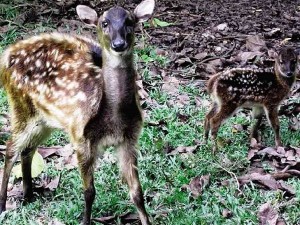Bid to save spotted deer in Negros bears fruit

SANDY and her fawn at the Biodiversity Conservation Center of Negros Forests and Ecological Foundation in Negros Occidental. CARLA P. GOMEZ/INQUIRER VISAYAS
BACOLOD CITY—The Biodiversity Conservation Center of Negros Forests and Ecological Foundation now has 14 Visayan spotted deer (Cervus alfredi) after another fawn was born in June.
Dr. Joanne Justo, the center’s curator, said on Thursday that the newborn fawn was born on June 24, but its gender had yet to be determined. It is the fourth offspring from breeding pair Girom and Sandy.
“The Visayan spotted deer is the largest endemic species of the Western Visayas faunal region,” Justo said.
She added that the species has been classified as critically endangered and is found only on Negros and Panay islands.
Justo cited deforestation, hunting and pet trade as factors in the decline in the number of the spotted deer.
Article continues after this advertisementThe center was established in 1996 to serve as a breeding and rescue station for endangered and endemic animals found on Negros Island and other parts of the country.
Article continues after this advertisementAside from the Visayan spotted dear, it also has rare warty pigs, leopard cats and bleeding heart pigeons, among other endangered animals.
The center breeds the species in captivity and releases mature animals back into the wild.
The release of mature animals back into the wild, however, is done only after it is proven that the animals’ habitat would be adequate and well-protected for their survival, according to Robert Harland, a trustee of the foundation.
In the meantime, the center is involved in animal exchanges or “breeding loans” with other institutions accredited by the Department of Environment and Natural Resources to ensure the genetic diversity of the captive population, Harland added.